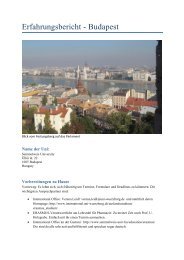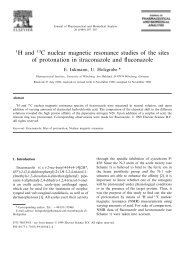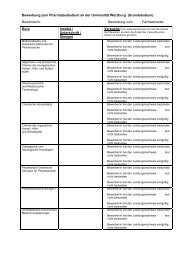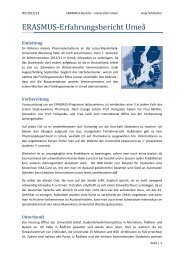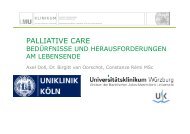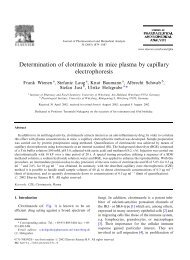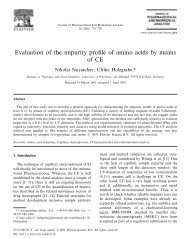Lipophilicity and membrane interactions of cationic-amphiphilic ...
Lipophilicity and membrane interactions of cationic-amphiphilic ...
Lipophilicity and membrane interactions of cationic-amphiphilic ...
You also want an ePaper? Increase the reach of your titles
YUMPU automatically turns print PDFs into web optimized ePapers that Google loves.
European Journal <strong>of</strong> Pharmaceutical Sciences 14 (2001) 167–175<br />
www.elsevier.nl/locate/ejps<br />
<strong>Lipophilicity</strong> <strong>and</strong> <strong>membrane</strong> <strong>interactions</strong> <strong>of</strong> <strong>cationic</strong>-<strong>amphiphilic</strong><br />
compounds: syntheses <strong>and</strong> structure–property relationships<br />
Christian D.P. Klein<br />
*, Gerald F. Tabeteh , Alice V. Laguna , Ulrike Holzgrabe , Klaus Mohr<br />
a, b b c b<br />
a<br />
Pharmaceutical Chemistry, ETH Zurich, ¨ Winterthurerstr. 190, CH-8057 Zurich, ¨ Switzerl<strong>and</strong><br />
b<br />
Department <strong>of</strong> Pharmacology <strong>and</strong> Toxicology, Pharmaceutical Institute, University <strong>of</strong> Bonn, An der Immenburg 4, D-53121 Bonn, Germany<br />
c<br />
Institute <strong>of</strong> Pharmacy <strong>and</strong> Food Chemistry, University <strong>of</strong> Wurzburg, ¨ Am Hubl<strong>and</strong>, D-97074 Wurzburg, ¨ Germany<br />
Received 22 December 2000; received in revised form 18 June 2001; accepted 18 June 2001<br />
Abstract<br />
This study was performed to elucidate the relationship between steric factors, lipophilicity, <strong>and</strong> the potency <strong>of</strong> <strong>cationic</strong>-<strong>amphiphilic</strong><br />
compounds to displace calcium ions from phosphatidylserine monolayers. The latter property is considered to be a substance/<br />
phospholipid affinity measure. A series <strong>of</strong> <strong>cationic</strong>-<strong>amphiphilic</strong> 3-phenyl-N,N-dimethylpropylamine derivatives with systematic structural<br />
variations was synthesized. <strong>Lipophilicity</strong> values were determined by chromatographic (RP-HPLC, log D<br />
7.4), shake-flask (log P), <strong>and</strong><br />
theoretical (CLOGP) techniques. The potency <strong>of</strong> the compounds to displace calcium ions from phosphatidylserine monolayers was<br />
45 21<br />
determined using a radiotracer technique, employing the isotope Ca . The experimental lipophilicity values <strong>of</strong> several isomeric<br />
biphenyl- <strong>and</strong> diphenyl-congeners differ more than could be expected from the CLOGP-calculations <strong>and</strong> show a good correlation to the<br />
calculated molecular surface areas. Although the affinity <strong>of</strong> the substances to the phospholipid monolayer tends to increase with<br />
lipophilicity, no general interrelation between the two properties could be found. Surprisingly, the assay system (a phospholipid<br />
monolayer) was quite sensitive towards small steric changes at the ‘lig<strong>and</strong>’ molecules. Stereochemical factors have a considerable<br />
influence on the interaction <strong>of</strong> solutes with phospholipid <strong>membrane</strong>s. It must be questioned whether lipophilicity measures alone, without<br />
taking other molecular features into account, can meaningfully be used to explain or predict the influence <strong>of</strong> solutes on <strong>membrane</strong>-related<br />
processes <strong>and</strong> properties. © 2001 Elsevier Science B.V. All rights reserved.<br />
Keywords: Phosphatidylserine; Solute-<strong>membrane</strong> <strong>interactions</strong>; <strong>Lipophilicity</strong>; Log P; Cationic-<strong>amphiphilic</strong>; Phospholipid monolayer<br />
1. Introduction <strong>interactions</strong>. If <strong>cationic</strong>-<strong>amphiphilic</strong> substances (see, for<br />
example, the general formula shown in Table 1) are added<br />
The interaction <strong>of</strong> drugs with biological <strong>membrane</strong>s is <strong>of</strong> to this system, the lipophilic parts <strong>of</strong> the molecules are<br />
major importance for their pharmacokinetic <strong>and</strong> pharmaco- incorporated into the hydrocarbon chain region <strong>of</strong> the<br />
dynamic properties. The essential structural feature <strong>of</strong> phospholipid monolayer. The <strong>cationic</strong> parts <strong>of</strong> the combio<strong>membrane</strong>s<br />
is the phospholipid bilayer, <strong>and</strong> artificial pounds are located within the phospholipid headgroup<br />
phospholipid preparations are <strong>of</strong>ten used as model systems region or at the phospholipid–water interface <strong>and</strong> displace<br />
for the probing <strong>of</strong> drug/bio<strong>membrane</strong> <strong>interactions</strong>. We calcium ions from their ionic ‘binding sites’. This process<br />
have established an assay system in which the adsorption is depicted in Fig. 1. The potency <strong>of</strong> <strong>cationic</strong> <strong>amphiphilic</strong><br />
21<br />
<strong>of</strong> Ca -ions to a phosphatidylserine monolayer, formed at compounds to displace calcium ions depends on their<br />
an air-buffer interface, can be measured by means <strong>of</strong> a affinity to the phosphatidylserine monolayer (Hauser <strong>and</strong><br />
radiotracer method (e.g., Girke et al., 1989). The addition Dawson, 1968; Scheufler et al., 1990; Vogelgesang <strong>and</strong><br />
<strong>of</strong> <strong>cationic</strong>-<strong>amphiphilic</strong> substances to the buffer solution Scheufler, 1990). It is usually expressed as the concen-<br />
21<br />
leads to a decrease in adsorbed Ca . The displacement <strong>of</strong><br />
21<br />
tration which leads to a 50% decrease in adsorbed Ca ,<br />
21<br />
Ca is due to an ion-exchanging effect: The negatively i.e. the IC50<br />
value.<br />
charged phosphatidylserine headgroups bind cations from We would like to present a dataset in which a common,<br />
the aqueous buffer, for example calcium ions, via ionic <strong>cationic</strong>-<strong>amphiphilic</strong> structure (N,N-dimethyl-3-phenylpropylamine,<br />
cpd. 1 <strong>of</strong> Table 1) has been systematically<br />
*Corresponding author. Tel.: 141-1-635-6072; fax: 141-1-635-6884. extended. In particular, we intended to clarify the relation-<br />
E-mail address: cklein@pharma.ethz.ch (C.D.P. Klein).<br />
ships between lipophilicity, steric factors, <strong>and</strong> the affinity<br />
0928-0987/01/$ – see front matter © 2001 Elsevier Science B.V. All rights reserved.<br />
PII: S0928-0987(01)00170-1
168 C.D.P. Klein et al. / European Journal <strong>of</strong> Pharmaceutical Sciences 14 (2001) 167 –175<br />
Table 1<br />
Structures, log P <strong>and</strong> log D7.4 values, <strong>and</strong> 2log IC50<br />
values <strong>of</strong> the dataset <strong>of</strong> <strong>cationic</strong>-<strong>amphiphilic</strong> compounds. All compounds were assayed as<br />
hydrochlorides<br />
a<br />
Cpd. log D7.4 log P CLOGP 2 log IC50<br />
(RP-HPLC, pH 7.4) (shake-flask, pH 12.5) (IC in mol/l)<br />
c c c<br />
50<br />
b<br />
1 R1–55H 1.50 n.d. 2.49 3.00<br />
2 R 5CH 2.00 n.d. 2.99 3.25<br />
1 3<br />
3 R 5C H 2.45 n.d. 3.52 3.45<br />
1 2 5<br />
4 R 5n-C H 2.88 n.d. 4.05 4.31<br />
1 3 7<br />
5 R 5i-C H 2.74 n.d. 3.92 3.60<br />
1 3 7<br />
6 R 5(C H ) CH 3.67 n.d. 4.98 4.92<br />
1 2 5 2<br />
7 R 5Phenyl 3.15 6.08 4.38 5.12<br />
1<br />
8 R 5Phenyl 3.02 6.20 4.38 4.70<br />
2<br />
9 R 5Phenyl 2.71 5.53 4.08 4.23<br />
3<br />
10 R 5Phenyl 2.34 5.40 3.93 3.93<br />
4<br />
11 R 5Phenyl 2.26 5.22 3.93 3.42<br />
5<br />
12 R 5OCH 1.48 n.d. 2.41 2.76<br />
1 3<br />
13 R 54-OCH –phenyl, 2.33 n.d. 3.85 3.79<br />
1 3<br />
R 5Phenyl<br />
4<br />
14 R 54-OH–phenyl, 1.06 n.d. 3.26 3.87<br />
1<br />
R 5Phenyl<br />
4<br />
15 R154-OCH 3–phenyl, 2.15 n.d. 3.85 3.29<br />
R55Phenyl<br />
16 3.19 n.d. 4.07 3.95<br />
17 2.13 n.d. 3.10 3.98<br />
a<br />
unless otherwise stated, all R5H.<br />
b<br />
n.d.: not determined.<br />
c<br />
n53–5 experiments, st<strong>and</strong>ard errors for the given values are smaller than 0.15 log units.<br />
Fig. 1. Cationic-<strong>amphiphilic</strong> compounds displace calcium ions from their ‘binding sites’ at the aqueous side <strong>of</strong> the phosphatidylserine monolayer.<br />
Phosphatidylserine <strong>of</strong> natural origin, which was used in the experiments, carries variable fatty acid chains <strong>and</strong> not necessarily palmitoyl chains as shown<br />
here.
C.D.P. Klein et al. / European Journal <strong>of</strong> Pharmaceutical Sciences 14 (2001) 167 –175 169<br />
to phosphatidylserine monolayers. The dataset shown here compounds. The CLOGP values were calculated for the<br />
is partially identical with a dataset given previously (Klein non-ionized species <strong>of</strong> the compounds.<br />
et al., 1999; Klein <strong>and</strong> Hopfinger, 1998). We would like to<br />
point out that all compounds which were also part <strong>of</strong> the<br />
previous dataset have been re-assayed, which accounts for 2.3. Experimental determination <strong>of</strong> partition coefficients<br />
minor differences between the former values <strong>and</strong> the ones<br />
presented here. It was necessary to re-determine these<br />
values because the employed phospholipid (phosphatidyl- 2.3.1. Shake-flask octanol/water partitioning<br />
serine) is <strong>of</strong> biological origin (bovine brain) <strong>and</strong> therefore Shake-flask octanol–water partition coefficients (Fujita<br />
the IC50<br />
values have a certain, though small, batch-to- et al., 1964) were determined for several isomeric bibatch<br />
variability. All values given here were determined phenyl- <strong>and</strong> diphenyl-propylamines (7–11). In order to<br />
using the same batch <strong>of</strong> phosphatidylserine.<br />
eliminate the ionized, <strong>cationic</strong> species <strong>of</strong> the compounds,<br />
For the previous dataset that also included other pharma- the partitioning experiments were carried out using a<br />
cological endpoints (antiarrhythmic activity <strong>and</strong> depression strongly basic (pH 12.5) aqueous buffer. We have previ<strong>of</strong><br />
a liposome phase transition temperature), we have tried ously measured pKa<br />
values <strong>of</strong> 9.5 to 10 for several close<br />
to develop Quantitative Structure–Activity Relationships analogs (Klein et al., 1999). Therefore, it can be assumed<br />
using intramolecular <strong>and</strong> intermolecular descriptors. that the <strong>cationic</strong> species was present in a concentration <strong>of</strong><br />
Whereas we succeeded in developing good QSAR models less than 1%.<br />
for the antiarrhythmic activity, the biophysical properties 1-Octanol <strong>of</strong> the best commercially available quality<br />
were more difficult to explain in a quantitative manner. was used for the shake-flask octanol/water partitioning<br />
The major drawback <strong>of</strong> the previous dataset was its experiments. The aqueous buffer consisted <strong>of</strong> trisodium<br />
fragmentation–the<br />
45 21<br />
Ca -displacing potency, for exam- phosphate trihydrate (0.2 M, 76.02 g/l) <strong>and</strong> potassium<br />
ple, was measured for only a few compounds <strong>of</strong> a hydrogen phosphate (0.1 M, 17.42 g/l), dissolved in<br />
congeneric series. In contrast, the present dataset allows a distilled water. The calculated pH <strong>of</strong> this buffer was 12.6,<br />
systematic study <strong>of</strong> steric <strong>and</strong> lipophilic effects.<br />
<strong>and</strong> a pH <strong>of</strong> 12.5 was measured. Buffer <strong>and</strong> octanol were<br />
saturated with each other <strong>and</strong> filtered before use. A diode<br />
array spectrophotometer (HP 8452A) with a 1 cm-cell was<br />
2. Material <strong>and</strong> methods used for the absorption measurements <strong>of</strong> the aqueous phase<br />
after partitioning, <strong>and</strong> the spectral data was stored <strong>and</strong><br />
2.1. Displacement <strong>of</strong><br />
45 21<br />
Ca from phospholipid evaluated using a computer (HP89532A UV–Vis s<strong>of</strong>tmonolayers<br />
ware). All experiments were run in triplicate <strong>and</strong> at room<br />
temperature (258C).<br />
A detailed description <strong>of</strong> the experimental procedure Plastic vials proved to be unsuitable for the partitioning<br />
®<br />
was given by Girke et al. (1989). In short, a teflon experiments, probably because the high lipophilicity <strong>of</strong> the<br />
planchette <strong>of</strong> 4.5 cm diameter was filled with 5 ml <strong>of</strong> compounds caused their adsorption at the container sur-<br />
®<br />
buffer (0.01 mM CaCl2<br />
supplemented with trace amounts face. Instead, glass vials with teflon seals were used.<br />
45<br />
<strong>of</strong> CaCl<br />
2, 5 mM NaCl, 2 mM TES, 2 mM histidine; pH All test compounds were dissolved (as hydrochloride<br />
7.5). Radioactivity was detected by a Geiger-Muller ¨ count- salts) in distilled water at a concentration <strong>of</strong> 2 mg/ml to<br />
ing tube (Frieseke & Hoepfner, Erlangen, Germany) give stock solutions. The amounts <strong>of</strong> sample, buffer <strong>and</strong><br />
positioned above the teflon dish. 3 nmol <strong>of</strong> phospha- octanol were chosen so that absorptions <strong>of</strong> 0.35 to 0.6 were<br />
tidylserine (from bovine brain; purity 98–99%, Sigma reached after partitioning. In case <strong>of</strong> the very lipophilic<br />
Chemical) dissolved in 1 ml <strong>of</strong> chlor<strong>of</strong>orm were carefully compounds 7 <strong>and</strong> 8, an absorption <strong>of</strong> only 0.17 <strong>and</strong> 0.25,<br />
applied to the surface <strong>of</strong> the buffer to form a phospholipid respectively, was measured. A typical partitioning experi-<br />
45 21<br />
monolayer. Adsorption <strong>of</strong> Ca to the phospholipid was ment was performed with 700 ml <strong>of</strong> sample stock solution<br />
indicated by a tw<strong>of</strong>old elevation <strong>of</strong> the counting rate under (corresponding to 1.4 mg <strong>of</strong> sample), 700 ml <strong>of</strong> buffer <strong>and</strong><br />
control conditions. Test compounds were dissolved in the 20 ml <strong>of</strong> octanol. All substances were pipetted into the<br />
buffer at the appropriate concentrations. An experiment vials, the octanol was added by microliter syringe, the vials<br />
included measurement <strong>of</strong> a range <strong>of</strong> concentrations in were shaked in a rotating shaking machine at 120 rpm for<br />
order to obtain a concentration/effect-curve for the dis- 60 min, centrifuged at 5000 rpm for 5 min to afford<br />
placement <strong>of</strong><br />
45 21<br />
Ca by a given test compound. Experi- complete phase separation, <strong>and</strong> the octanol was removed.<br />
ments were repeated three to five times.<br />
The absorption <strong>of</strong> the aqueous phase was determined. In<br />
most cases, absorptions were measured at the maximum <strong>of</strong><br />
2.2. Calculation <strong>of</strong> partition coefficients the B-b<strong>and</strong>. The concentration in the octanol layer was<br />
determined by difference. Calibration was done in exactly<br />
The ‘CLOGP for Windows V. 4.0.0’ program (Biobyte the same manner as the partitioning, except that no octanol<br />
Corp.) was used to calculate CLOGP values for the target <strong>and</strong> smaller amounts <strong>of</strong> sample were used.
170 C.D.P. Klein et al. / European Journal <strong>of</strong> Pharmaceutical Sciences 14 (2001) 167 –175<br />
2.3.2. RP-HPLC recorded using KBr tablets (Perkin-Elmer spectrometer,<br />
The distribution coefficients (log D<br />
7.4) <strong>of</strong> all target model 298). Combustion analyses (C, H, N) for the target<br />
compounds were determined by RP-chromatography with compounds gave results within60.4% <strong>of</strong> the calculated<br />
methanol/aqueous buffer (60/40 <strong>and</strong> 30/70) mobile values. All starting compounds were used as received<br />
phases (cf. Kaliszan (1990) for a review <strong>of</strong> log P de- (Merck, Fluka, Sigma-Aldrich). An overview <strong>of</strong> the syntermination<br />
by HPLC). The chromatographic systems were thetic pathways is given in Fig. 2.<br />
calibrated with solutes for which an experimentally de-<br />
13<br />
C NMR spectral data will be provided upon request.<br />
termined octanol/water partition-coefficient was available 1–5, 7, 10, 12: Synthesized as described previously<br />
(Hansch et al., 1995) <strong>and</strong> which are not charged at pH 7.4. (Klein et al., 1999).<br />
The capacity factors <strong>of</strong> the reference substances were 6, N,N-Dimethyl-3-(4-[3-pentyl]-phenyl)-propylamine<br />
correlated against the experimental octanol/water log P hydrochloride: 4-(3-Pentyl)-acetophenone (6a) was synvalues,<br />
<strong>and</strong> the correlation equation, thus obtained, was thesized from propiophenone in a two-step synthesis<br />
used to calculate lipophilicity values (now log D, because according to Cram (1952). Purified by distillation in vacuo.<br />
D 1<br />
the test compounds are ionized at pH 7.4) for the test 6a: bp 150–1538C [22 hPa], n20 1.5171, H NMR (CDCl<br />
3,<br />
2 6<br />
compounds. d ): 7.88 (d, 2 H, J58.4 Hz, H , H aro), 7.20 (d, 2 H,<br />
3 5<br />
The RP-HPLC system for the determination <strong>of</strong> log D7.4 J58.3 Hz, H , H aro), 2.55 (s, 3 H, COCH<br />
3), 2.38 (m, 1<br />
21<br />
values consisted <strong>of</strong> a Kontron Instruments HPLC pump H), 1.45–1.75 (m, 4 H), 0.73 (m, 6 H); IR [cm ] (film):<br />
‘420’, a Rheodyne injection valve with 50 ml sample loop, 2960, 1680, 1605, 1270. 6a (0.01 mol, 1.9 g) was<br />
a GromSil ODS-2 5 mm ‘fully endcapped’ 12534 mm converted to the corresponding chloropropeniminium salt<br />
column, <strong>and</strong> a Perkin Elmer LC-480 Autoscan diode array (3-chloro-3-(4-[3-pentyl]-phenyl) - prop - 2 - ene - 1 - ylidenedetector.<br />
The chromatographic data were stored <strong>and</strong> evalu- N,N-dimethyliminium perchlorate, 6b) in 60% yield by the<br />
ated on a PC (LabControl LC-DESplus s<strong>of</strong>tware). A previously described method (Klein et al. (1999), Method<br />
1<br />
methanol/buffer (60/40 or 30/70) mobile phase was used B). 6b: yellow crystals, mp 1608C. H NMR (CD3CN, d ):<br />
at a flow rate <strong>of</strong> 2 ml/min. The buffer was a pH 7.4 8.73 (d, 1 H, J510 Hz, CH–CH5N), 7.96 (d, 2 H, J58.6<br />
phosphate buffer, obtained by mixing a 0.2 M potassium Hz, H aro), 7.39 (d, 2 H, J58.5 Hz, H aro), 7.31 (d, 1 H,<br />
dihydrogen phosphate solution (1000 ml) <strong>and</strong> 0.1 M J510 Hz, CH–CH5N), 3.69 (s, 3 H, E–CH5N(CH )),<br />
3 2<br />
sodium hydroxide (1573.6 ml). N,N-Dimethylhexylamin 3.57 (s, 3 H, Z–CH5N(CH ) ), 2.45–2.55 (m, 1 H,<br />
3 2<br />
(0.02%) was added to the mobile phase to shield unreacted CH(CH2CH 3) 2), 1.50–1.80 (m, 4 H, CH(CH2CH 3) 2),<br />
21<br />
silanol groups <strong>and</strong> minimize peak tailing (Gill et al., 0.75 (m, 6 H, CH(CH CH ) ); IR [cm ]: 2940, 1640,<br />
2 3 2<br />
1982). The column <strong>and</strong> the mobile phase were thermo- 1075. 6b was hydrogenated (H<br />
2: 300–400 kPa) in methastated<br />
at 308C (water bath, Haake Thermostat D1).<br />
nol solution over Pd/C (10%) catalyst, followed by the<br />
Aromatic compounds with known octanol/water parti- usual workup procedures, to give the desired 6 in quantita-<br />
1<br />
tion coefficients (Hansch et al., 1995) were used for the tive yield. 6: White crystals, mp 1388C. H NMR (CD3OD,<br />
calibration <strong>of</strong> the system (benzene, chlorobenzene, toluene, d ): 7.15 (d, 2 H, J57.1 Hz, H aro), 7.09 (d, 2 H, J57.1<br />
ethylbenzene, cumene, phenylethanol, biphenyl, anth- Hz, H aro), 3.14 (m, 2 H, CH<br />
2–N(CH 3) 2), 2.87 (s, 6 H,<br />
3<br />
racene, N,N-dimethylaniline). All analytes were dissolved N(CH ) ), 2.69 (m, 2 H, C H ), 2.25–2.30 (m, 1 H,<br />
3 2 2<br />
2<br />
2 3 2 2<br />
in methanol at a concentration <strong>of</strong> 300 mg/ml. Experiments CH(CH CH ) ), 2.00–2.10 (m, 2 H, C H ), 1.49–1.70<br />
were run in triplicate, <strong>and</strong> peak maxima were determined (m, 4 H, CH(CH2CH 3) 2), 0.75 (m, 6 H, CH(CH2CH 3)).<br />
2<br />
21<br />
at the respective absorption maximum. Capacity ratios IR [cm ]: 2950, 1460.<br />
were determined as k95(t 2t )/t , where t is the average 8, 3-(39-Biphenylyl)-N,N-dimethylpropylamine hydror<br />
0 0 r<br />
retention time <strong>of</strong> the analyte <strong>and</strong> t0<br />
is the ‘retention’ time chloride: 3-Phenylbenzaldehyde (8a) (Shoppee, 1933) was<br />
<strong>of</strong> a non-retained compound (thiourea). A linear regression synthesized in a 4-step synthesis from 3-nitroaniline. 3-<br />
analysis was performed for the log k9/log P data <strong>of</strong> the Nitroaniline was converted to 3-nitrobiphenyl following<br />
reference compounds, <strong>and</strong> the regression equations were the procedure described by Elks et al. (1940). This nitro<br />
used to calculate the log D7.4<br />
<strong>of</strong> the compounds. The compound was reduced to give 3-aminobiphenyl, which,<br />
equations were: (MeOH/H2O 60/40) log D7.452.04 log upon diazotation <strong>and</strong> reaction with potassium iodide,<br />
2<br />
k911.37, n59, R 50.99; (MeOH/H O 30/70) log D 5 afforded 3-iodobiphenyl (Campaigne <strong>and</strong> Reid, 1946).<br />
2<br />
2 7.4<br />
2.21 log k9 20.59, n54, R 50.98. Conversion to the Grignard reagent <strong>and</strong> reaction with<br />
N-formylpiperidine (following the procedure <strong>of</strong> Olah <strong>and</strong><br />
2.4. Syntheses <strong>and</strong> analytical data Arvanaghi, 1981) gave 8a in 60% yield. Purification by<br />
column chromatography (silica gel, petrol ether/ethyl<br />
1 D 1<br />
20 3<br />
NMR spectra were recorded at 299.956 MHz ( H) or acetate 90/10). 8a: n 1.6277; H NMR (CDCl , d ):<br />
13<br />
75.443 MHz ( C) on a Varian XL 300 FT-NMR spec- 10.10 (s, 1 H, Ar–CHO), 7.38–8.12 (m, 9 H, H aro); IR<br />
trometer, with the solvent proton/carbon signals being<br />
21<br />
[cm ] (film): 1690 b, 1590, 1180, 750. To a stirred<br />
used as internal st<strong>and</strong>ard for the calibration <strong>of</strong> the fre- suspension <strong>of</strong> N,N-dimethylaminoethyltriphenylphosquency<br />
scale. Unless otherwise stated, all IR spectra were phonium bromide (0.00321 mol, 1.34 g) (prepared accord-
C.D.P. Klein et al. / European Journal <strong>of</strong> Pharmaceutical Sciences 14 (2001) 167 –175 171<br />
Fig. 2. Overview <strong>of</strong> synthetic pathways.<br />
ing to Marxer <strong>and</strong> Leutert, 1978) in THF (15 ml), an give the desired 3-(39-biphenylyl)-N,N-dimethylpropylequimolar<br />
solution <strong>of</strong> 1.4 M n-butyllithium in n-hexane amine hydrochloride (8) in quantitative yield. 8: mp<br />
1<br />
was added under nitrogen at 08C. After 30 min a solution 1458C; H NMR (CDCl<br />
3, d ): 7.63–7.11 (m, 9 H, H aro),<br />
1<br />
<strong>of</strong> 8a (0.00321 mol, 0.584 g) in THF (7 ml) was slowly 3.02–2.96 (t, 2 H, J57.5 Hz, C H), 2.79 (t, 2 H, J57.7<br />
3<br />
added, <strong>and</strong> the reaction mixture was stirred overnight at Hz, C H), 2.77 (s, 6 H, N(CH<br />
3) 2), 2.21–2.27 (m (b), 2 H,<br />
2 21<br />
608C. The solution was acidified with 3 N hydrochloric C H); IR [cm ]: 2490, 1480, 760.<br />
acid (10 ml) <strong>and</strong> the tetrahydr<strong>of</strong>uran was removed in 9, 3-(29-Biphenylyl)-N,N-dimethylpropylamine hydrovacuo.<br />
After extraction with toluene (2310 ml) the water chloride: 2-Aminobiphenyl was converted to 2-<br />
phase was made alkaline with 2 N sodium hydroxide <strong>and</strong> iodobiphenyl following the procedure given by Gilman et<br />
extracted with diethyl ether (3320 ml). The N,N-di- al. (1929). From 2-iodobiphenyl, 2-phenylbenzaldehyde<br />
methyl-39-phenylcinnamylamine base was obtained by (Zaheer <strong>and</strong> Faseeh, 1944) (9a) was prepared in 80% yield<br />
stripping the dried (K2CO 3) extracts <strong>of</strong> solvent in vacuo, using the method <strong>of</strong> Olah <strong>and</strong> Arvanaghi (1981). Purified<br />
D<br />
<strong>and</strong> converted to the hydrochloride by the addition <strong>of</strong> by distillation in vacuo. 9a: bp 1378C (7 hPa), n20<br />
1.6210;<br />
1<br />
ethereal hydrochloric acid. The hydrochloride salt (8b, H NMR (CDCl<br />
3, d ): 10.00 (d, 1 H, J50.9 Hz, carbonyl–<br />
yield: 50%) was recrystallized from ethanol/diethyl ether. H), 8.07 (d, 1 H, J57.9 Hz, H aro), 7.0–7.7 (m, 9 H, H<br />
1 21<br />
8b: mp1648C. H NMR (CDCl<br />
3, d ): 7.61–7.26 (m, 9 H, aro); IR [cm ] (film): 3040, 2820, 1680. This compound<br />
3<br />
J515.9 Hz, H aro), 6.82 (d, 1 H, C H), 6.50 (dt, 1 H, was converted to N,N-dimethyl-29-phenylcinnamylamine<br />
2 1<br />
J515.9, 7.3 Hz, C H), 3.79 (d, 2 H, J57.3 Hz, C H), hydrochloride (9b) by the procedure given above for 8a<br />
21 1<br />
2.82 (s, 6 H, N(CH<br />
3) 2); IR [cm ]: 2680, 2080, 1480, 970, (yield: 30%). 9b: mp.1908C. H NMR (CDCl<br />
3, d ): 7.45–<br />
760. 8b was hydrogenated as described above for 6b, to 7.28 (m, 8 H, H aro), 7.14 (d, 1 H, J57.6 Hz, H aro), 6.93
172 C.D.P. Klein et al. / European Journal <strong>of</strong> Pharmaceutical Sciences 14 (2001) 167 –175<br />
3<br />
(d, 1 H, J511.5 Hz, C H), 6.00 (dt, 1 H, J511.5, 7.1 was obtained in 47% yield with respect to 13a. The<br />
2 1<br />
Hz,C H), 3.60 (d, 2 H, J57.0 Hz, C H), 2.61 (s, 6 H, compound is strongly hygroscopic; therefore, no meaning-<br />
21 1<br />
N(CH<br />
3) 2); IR [cm ]: 2640, 1465, 735. Catalytic hydro- ful melting point could be determined. 13: H NMR (D2O,<br />
2 6<br />
genation (see 6b) afforded to desired 3-(29-biphenylyl)- d ): 7.40 (m, 5 H, H aro), 7.33 (d, 2 H, J58.6 Hz, H , H<br />
N,N-dimethylpropylamine hydrochloride (9) in quantita-<br />
3 5<br />
aro), 6.95 (d, 2 H, J58.6 Hz, H , H aro), 4.00 (t, 1 H,<br />
1 3<br />
tive yield. 9: mp 1158C. H NMR (CDCl31 CD3OD, d ): C H), 3.76 (s, 3 H, Ar–OCH<br />
3), 3.00 (m, 2 H, CH<br />
2–<br />
1<br />
7.16–7.42 (m, 9 H, H aro), 2.70–2.80 (m, 2 H, C H), 2.59 N(CH<br />
3) 2), 2.88 (s, 6 H, N(CH<br />
3) 2), 2.38 (m, 2 H, CH–<br />
3 21<br />
(s, 6 H, N(CH<br />
3) 2), 2.56 (m, 2 H, C H), 1.84 (m, 2 H, CH<br />
2–CH 2–N); IR [cm ]: 1610, 1250, 1030.<br />
2 21<br />
C H); IR [cm ]: 2650 b, 1460, 750.<br />
14, N,N-Dimethyl-3-(4-hydroxyphenyl)-3-phenylpropyl-<br />
11, N,N-Dimethyl-2,3-diphenyl-propylamine hydrochloin<br />
amine hydrochloride: A solution <strong>of</strong> 13 (3.16 g, 0.01 mol)<br />
ride (Wawzonek <strong>and</strong> Nagler, 1955): 2,3-Diphenylreflux<br />
concentrated hydrobromic acid (40 ml) was heated to<br />
propionitrile was prepared as described by Abe <strong>and</strong><br />
for 2 h. After cooling, water (100 ml) was added<br />
Miyano (1972). 0.02 mol (4.15 g) <strong>of</strong> this compound was <strong>and</strong> the resulting mixture was alkalized with conc. amdissolved<br />
in ethanol (20 ml). A 33% solution <strong>of</strong> dithree<br />
monia to give pH 9. The resulting solution was extracted<br />
methylamine in ethanol (0.3 mol, 40 g) <strong>and</strong> 10% palladium<br />
times with 75 ml <strong>of</strong> diethyl ether. The combined<br />
on barium sulfate (2 g) were added. The reaction mixture organic layers were washed twice with water, dried over<br />
was then shaked under hydrogen (300–400 kPa) until the K2CO 3, <strong>and</strong> about 120 ml <strong>of</strong> the solvent were evaporated.<br />
theoretical uptake <strong>of</strong> hydrogen had occurred. The catalyst Addition <strong>of</strong> ethereal hydrochloric acid gave the crude<br />
was removed by filtration <strong>and</strong> the filtrate evaporated to phenol hydrochloride, which was recrystallized from ace-<br />
dryness. The residue was dissolved in water (50 ml) <strong>and</strong><br />
1<br />
tone/diethyl ether. Yield: 70%. 14: mp 2128C. H NMR<br />
brought to pH 11 by adding 2 N sodium hydroxide.<br />
Subsequent extraction with diethyl ether (3350 ml),<br />
(CD3OD, d ): 7.28 (m, 5 H, CH aro), 7.13 (d, 2 H, J58.5<br />
Hz, H<br />
2<br />
, H<br />
6<br />
aro), 6.73 (d, 2 H, J58.6 Hz, H<br />
3<br />
, H<br />
5<br />
aro), 3.93<br />
drying <strong>of</strong> the pooled extracts (K2CO 3), <strong>and</strong> evaporation <strong>of</strong> (t, 1 H, CH), 3.00 (m, 2 H, CH<br />
2–N(CH 3) 2), 2.82 (s, 6 H,<br />
21<br />
the solvent under vacuum yielded the crude base, which N(CH<br />
3) 2), 2.46 (m, 2 H, CH–CH<br />
2–CH 2); IR [cm ]:<br />
was separated from the primary amine by-product by 2960, 1515, 1260, 1220, 705.<br />
flash-chromatograpy (silica gel, mobile phase: ethyl aceylamine<br />
15, N,N-Dimethyl-2-phenyl-3-(4-methoxyphenyl)-prop-<br />
tate/petroleum ether/conc. ammonia 900/500/10). The<br />
hydrochloride (Kindler et al., 1948): 2-Phenyl-3-<br />
N,N-dimethyl-2,3-diphenyl-propylamine hydrochloride (4-methoxyphenyl)-propionitrile (0.02 mol, 4.75 g), syn-<br />
(11) was prepared in the usual manner by precipitation thesized according to the procedure <strong>of</strong> Abe <strong>and</strong> Miyano<br />
with ethereal hydrochloric acid <strong>and</strong> was recrystallized from (1972), was treated with H<br />
2<br />
/Pd–C/dimethylamine as<br />
1<br />
acetone/diethyl ether. Yield: 70%. 11: mp 1698C; H described above for cpd. 11. The same workup procedure<br />
NMR (CDCl<br />
3, d ): 6.98–7.29 (m, 10 H, H aro), 3.5–3.6 as for cpd. 11 was employed, giving a yield <strong>of</strong> 85%<br />
2 1<br />
(m, 1 H, C H), 3.25–3.45 (m, 2 H, C H), 3.07 (dd, 1 H, N,N-dimethyl-2-phenyl-3-(4-methoxyphenyl)-propylamine<br />
3<br />
1<br />
J56.7, 13.6 Hz, C H), 2.89 (dd, 1 H, J58.3, 13.6 Hz, hydrochloride (15). 15: mp 1428C. H NMR (CD3OD, d ):<br />
3<br />
3 5<br />
C H), 2.60 (d, 3 H, J54.9 Hz, N(CH<br />
3) 2), 2.49 (d, 3 H, 7.15–7.30 (m, 5 H, H aro), 6.91 (d, 2 H, J58.7 Hz, H , H<br />
21<br />
2 6<br />
J54.9 Hz, N(CH<br />
3) 2); IR [cm ]: 2450, 1440, 690. aro), 6.69 (d, 2 H, J58.7 Hz, H , H aro), 3.70 (s, 3 H,<br />
2 1<br />
13, N,N-Dimethyl-3-(4-methoxyphenyl)-3-phenylpropyl- Ar–OCH<br />
3), 3.50 (m, 1 H, C H), 3.35 (m, 2 H, C H), 3.00<br />
3 3<br />
amine hydrochloride: 4-Methoxyacetophenone was treated (dd, 1 H, C H), 2.85 (dd, 1 H, C H), 2.56 b (s, 6 H,<br />
21<br />
with phenylmagnesiumbromide, affording 1-(4-methox- N(CH<br />
3) 2); IR [cm ]: 3490, 1505, 1240.<br />
yphenyl)-1-phenylethanol (Novak <strong>and</strong> Protiva, 1959) 16, N,N-Dimethyl-3-(2-tetralyl)-propylamine hydrochlo-<br />
(13a). 0.1 Mol <strong>of</strong> the carbinol 13a were dissolved in ride: 2-Acetyltetralin (Smith <strong>and</strong> Lo, 1948) (16a) was<br />
anhydrous N,N-dimethylformamide (0.65 mol, 47.5 g, 50.0 synthesized from tetralin using the method described by<br />
ml). The mixture was cooled in an ice bath, <strong>and</strong> phosphormethoxynaphthalene.<br />
Arsenijevic et al. (1988) for the synthesis <strong>of</strong> 2-acetyl-6-<br />
us oxychloride (0.2 mol, 30 g, 17.9 ml) was added<br />
16a (0.0115 mol, 2 g) was converted<br />
dropwise, while the internal temperature was kept below to the corresponding chloropropeniminium salt (3-chloro-<br />
108C. Stirring was continued for 24 h at ambient temperaperchlorate,<br />
3-(2-tetralyl)-prop-2-ene-1-ylidene-N,N-dimethyliminium<br />
ture. Afterwards, the mixture was poured into an ice-cold<br />
16b) in 55% yield by the previously described<br />
methanol/water (3/2) mixture, <strong>and</strong> 70% perchloric acid method (Klein et al. (1999), Method B). 16b: mp 1658C.<br />
(25 ml) was added to precipitate the perchlorate salt. This 1 H NMR (CD3CN, d ): 8.69 (d, 1 H, J510.3 Hz, CH–<br />
caused the precipitation <strong>of</strong> a yellowish, semi-solid mass, CH5N), 7.70 (m, 2 H, H aro), 7.25 (m, 2 H, CH–CH5N/<br />
which was removed manually. The crude 3-(4-methoxy- H aro), 3.68 (s, 3 H, E–CH5N(CH<br />
3) 2), 3.56 (s, 3 H,<br />
phenyl) - 3 - phenylprop - 2 - ene - 1 - ylidene-N,N - dimethyl- Z–CH5N(CH<br />
3) 2), 2.83 (s (b), 4 H, Ar(CH<br />
2) 2(CH 2) 2),<br />
21<br />
iminium perchlorate (13b) could be hydrogenated without 1.80 (m, 4 H, Ar(CH<br />
2) 2(CH 2) 2); IR [cm ]: 2920, 1650,<br />
further purification (see description for 6b). The crude 1570, 1090. Catalytic hydrogenation <strong>of</strong> 16b (see cpd. 6a)<br />
product base was distilled in vacuo. N,N-Dimethyl-3-(4- afforded N,N-dimethyl-3-(2-tetralyl)-propylamine hydromethoxyphenyl)-3-phenylpropylamine<br />
hydrochloride (13)<br />
1<br />
chloride (16) in quantitative yield. 16: mp 1728C. H NMR
C.D.P. Klein et al. / European Journal <strong>of</strong> Pharmaceutical Sciences 14 (2001) 167 –175 173<br />
(D2O, d ): 7.01–7.07 (m, 3 H, H aro), 3.13–3.18 (m, 2 H, lipophilicity <strong>and</strong> devised a new method for the calculation<br />
CH<br />
2–N(CH 3) 2), 2.92 (s, 6 H, N(CH<br />
3) 2), 2.65–2.74 (m, 6 <strong>of</strong> log P values. We built analogs 7–11 with the di-<br />
H, Ar(CH<br />
2)(CH));CH 2 2 2 2–CH 2–CH 2–N), 1.99–2.09 (m, methylaminopropyl side chain in all-trans conformation,<br />
2 H, CH<br />
2–CH 2–CH 2–N), 1.76 (m, 4 H, performed a geometry optimization using the AM1<br />
21<br />
Ar(CH<br />
2 )<br />
2 (CH<br />
2 )<br />
2 ); IR [cm ]: 2910, 1250, 790.<br />
semiempirical hamiltonian (MOPAC 6.0 (Stewart, 1990)),<br />
17: Synthesized according to Marxer <strong>and</strong> Leutert determined their Connolly surface areas (probe radius 1.4<br />
(1978). Å) (Cerius2, v.3.0) <strong>and</strong> correlated it to their log D7.4<br />
(RP-HPLC) values. The results are shown in Fig. 3.<br />
Although the statistical significance <strong>of</strong> a dataset with n55<br />
is limited, we think that there is a clear dependency<br />
3. Results <strong>and</strong> discussion between surface area <strong>and</strong> log P or log D<br />
7.4. Bulky<br />
compounds, such as 10 <strong>and</strong> 11, expose less <strong>of</strong> their<br />
All experimental results are given in Table 1, along with aromatic, lipophilic surface areas than the elongated comthe<br />
calculated log P values. Overall, the CLOGP program pounds (7, 8). This is reflected by higher log P/log D 7.4<br />
performed quite well in predicting the relative lipo- values in the latter case. An attempt to correlate the surface<br />
philicities <strong>of</strong> the compounds in the dataset.<br />
area <strong>of</strong> the other compounds with their log D values failed.<br />
Initially, we did not intend to determine any log P values This could be due to the different number <strong>of</strong> aromatic rings<br />
by the shake-flask method, <strong>and</strong> wanted to rely solely on the in the compounds.<br />
RP-HPLC method. However, the chromatographic log D7.4<br />
We would now like to focus on the interaction <strong>of</strong> the<br />
values for the isomeric compounds 7–11 were more analogs with phosphatidylserine monolayers. Over all,<br />
different than we expected. Whereas the calculated log P there certainly is a dependency between the lipophilicity<br />
values (CLOGP) vary from 3.93 to 4.38, the chromato- <strong>and</strong> the calcium-displacing potency <strong>of</strong> the compounds (see<br />
graphic method gave log D7.4<br />
values from 2.26 to 3.15. It Fig. 4). However, a more detailed consideration <strong>of</strong> the data<br />
should be noted that molecular modeling programs which in Table 1 gives a picture that is less clear.<br />
calculate log P values by means <strong>of</strong> an atom-based ap- The calcium-displacing potency, expressed as 2log<br />
proach predicted an even smaller difference in lipo- IC<br />
50, <strong>of</strong> the isomers 7–11 increases with lipophilicity, <strong>and</strong><br />
2<br />
philicities than CLOGP. The majority <strong>of</strong> commercial one finds a good, linear correlation (r 0.94; log D7.4<br />
from<br />
modeling programs uses atom-based approaches for the RP-HPLC) for the two properties — for this data-subset.<br />
calculation <strong>of</strong> log P values. Of course, some steric in- If, however, other compounds are considered, the relationfluence<br />
could be expected, but we began to doubt the ship between lipophilicity <strong>and</strong> <strong>membrane</strong> interaction bevalidity<br />
<strong>of</strong> the HPLC method <strong>and</strong> decided to perform comes much more vague. For example, compounds 7 <strong>and</strong><br />
‘classical’ shake-flask experiments for cpds. 7–11. Be- 16 are practically iso-lipophilic, whereas their potency to<br />
21<br />
cause the shake-flask technique can, due to experimental displace Ca -ions from phosphatidylserine monolayers<br />
problems (formation <strong>of</strong> micelles, accumulation <strong>of</strong> the differs by more than an order <strong>of</strong> magnitude. The same<br />
compounds at the octanol–water interface), not be per- observation, although less pronounced, can be made for<br />
fomed with <strong>amphiphilic</strong> compounds (5surfactants), it was compounds 9 <strong>and</strong> 5. In both cases, the bi-aromatic analogs<br />
necessary to use a strongly basic, aqueous buffer, in which (7, 9) are distinctly more active than the iso-lipophilic<br />
the ionized, <strong>amphiphilic</strong> species is practically eliminated.<br />
Therefore, a phosphate/hydrogen phosphate buffer was<br />
used for the partitioning experiments. Not surprisingly,<br />
compounds 7–11 are three orders <strong>of</strong> magnitude more<br />
lipophilic (as determined by the shake-flask method) at pH<br />
12.5 than at pH 7.4 (RP-HPLC). Nevertheless, the correlation<br />
between shake-flask- <strong>and</strong> RP-HPLC-values is good,<br />
<strong>and</strong> both methods give values for cpds. 7–11 that differ<br />
(‘within’ each method) by about one order <strong>of</strong> magnitude.<br />
What is the reason for the large variation <strong>of</strong> the log P<br />
values for cpds. 7–11? It appeared obvious to determine<br />
the molecular surface areas <strong>of</strong> these isomers <strong>and</strong> see if<br />
there was any interrelation with the log P values. Correlations<br />
between log P <strong>and</strong> surface area are not a new<br />
concept. Yalkowski <strong>and</strong> Valvani (1976) used the solventaccessible<br />
surface area <strong>of</strong> hydrocarbons to calculate their<br />
lipophilicity. These studies were later extended by Camilleri<br />
<strong>and</strong> colleagues (1988), who correlated the Connolly Fig. 3. Correlation <strong>of</strong> Connolly surface area versus log P for compounds<br />
(1983) surface areas <strong>of</strong> benzene derivatives to their 7–11. A probe radius <strong>of</strong> 1.4 A˚<br />
was used.
174 C.D.P. Klein et al. / European Journal <strong>of</strong> Pharmaceutical Sciences 14 (2001) 167 –175<br />
45 21<br />
Fig. 4. Correlation plot <strong>of</strong> 2log IC<br />
50<br />
(displacement <strong>of</strong> Ca from<br />
phosphatidylserine monolayers) versus log D<br />
7.4<br />
<strong>of</strong> all compounds.<br />
for the remaining dataset becomes 0.75. This observation<br />
shows once more that small structural changes can have a<br />
large influence on the interaction <strong>of</strong> solutes with phospholipid<br />
<strong>membrane</strong>s. The mechanistic background for the<br />
strong activity <strong>of</strong> compound 14 can only be hypothesized.<br />
One possible explanation could be that the phenolic moiety<br />
<strong>of</strong> compound 14 represents an additional ‘binding partner’<br />
for the monolayer/water interface, thereby increasing the<br />
compound’s affinity.<br />
The main conclusion that can be drawn from this work<br />
is that the interaction <strong>of</strong> phospholipid assemblies with<br />
solute molecules can have a remarkably high steric selectivity.<br />
The effect observed here, i.e. displacement <strong>of</strong><br />
45 21<br />
Ca , reflects binding <strong>of</strong> the <strong>cationic</strong> model <strong>amphiphilic</strong><br />
compounds. The octanol/water partition coefficient (log P)<br />
<strong>of</strong> the solutes might be a useful parameter for the prediction<br />
or explanation <strong>of</strong> general trends <strong>of</strong> binding affinity.<br />
However, other factors appear to be involved <strong>and</strong> minor<br />
steric variations may have a pronounced impact on the<br />
adsorption, absorption, <strong>and</strong> penetration behavior <strong>of</strong> small<br />
molecules.<br />
alkyl-aromatic compounds (5, 16) This is probably due to<br />
the rigidity <strong>of</strong> the biphenyl moieties, which aids their<br />
‘intercalation’ between the fatty acid chains <strong>of</strong> the phospholipids.<br />
The four compounds 2, 11, 15, <strong>and</strong> 17 have similar<br />
lipophilicities (log D : 2.00–2.26). The calcium-displac-<br />
Acknowledgements<br />
7.4<br />
ing potency <strong>of</strong> cpds. 2, 11, <strong>and</strong> 15 is about the same (2log<br />
D. Heber <strong>and</strong> M. Klingmuller ¨<br />
IC around 3.3), whereas 17 is distinctly more active<br />
<strong>of</strong> the University <strong>of</strong> Kiel,<br />
50<br />
(2log IC : 3.98). Furthermore, the calcium-displacing<br />
Pharmaceutical Institute, kindly provided cpds. 2, 3, <strong>and</strong> 4.<br />
50<br />
potency does not increase with lipophilicity. 17, the most<br />
C.K. appreciates financial support by the Konrad-<br />
active compound in this sub-group, is less lipophilic than<br />
Adenauer-Foundation.<br />
11 <strong>and</strong> 15. Compound 2, carrying a methyl group in the<br />
4-position, is nearly iso-lipophilic with cpd. 17 that has a<br />
chlorine in the 4-position. Another structural difference References<br />
between 2 <strong>and</strong> 17 is that 17 has an unsaturated side chain.<br />
Here, one might guess that the increased activity is due to Abe, N., Miyano, S., 1972. C-alkylation <strong>of</strong> active methylene compounds<br />
the fact that the side chain <strong>of</strong> 17 is more rigid, therefore by means <strong>of</strong> alcohols. VII. Synthesis <strong>of</strong> a-substituted phenylacetonitriles<br />
from a-phenylacetoacetonitrile. J. Org. Chem. 37, 526–528.<br />
facilitating the insertion <strong>of</strong> the compound into the phospholipid<br />
monolayer.<br />
Arsenijevic, L., Arsenijevic, V., Horeau, A., Jacques, J., 1988. Acetyl-6-<br />
methoxynaphthalene. In: Nol<strong>and</strong>, W.E. (Ed.). Org. Synth. Coll, Vol. VI.<br />
A very interesting observation was made with com- Wiley & Sons, New York, pp. 34–36.<br />
pounds 4 <strong>and</strong> 5, 4 carrying an n-propyl <strong>and</strong> 5 carrying an Camilleri, P., Watts, S.A., Boraston, S.A., 1988. A surface area approach<br />
iso-propyl group at the 4-position. These two geometric to determination <strong>of</strong> partition coefficients. J. Chem. Soc. Perkin Trans.<br />
isomers, whose log D values are 2.88 <strong>and</strong> 2.74, have 2, 1699–1707.<br />
7.4<br />
2log IC values <strong>of</strong> 4.31 <strong>and</strong> 3.60, respectively. This Campaigne, E., Reid, B.M., 1946. Some substituted acetophenones. J.<br />
50<br />
21<br />
Am. Chem. Soc 68, 1663.<br />
means that their potency to displace Ca -ions from Cerius2, V.3.0 User Guide. San Diego: Molecular Simulations Inc., 1997.<br />
phosphatidylserine monolayers differs by a factor <strong>of</strong> about CLOGP for Windows, release 4.0. BioByte Corp., Claremont, USA,<br />
5. We think that it is quite interesting to find such a degree 1999.<br />
<strong>of</strong> sensitivity to small steric changes in an assay system (a Connolly, M.L., 1983. Solvent-accessible surfaces <strong>of</strong> proteins <strong>and</strong> nucleic<br />
phospholipid monolayer) which is generally expected to be acids. Science 221, 709–713.<br />
Cram, D.J., 1952. Studies in stereochemistry. VIII. Molecular rearrangenot<br />
very dem<strong>and</strong>ing with respect to the geometries <strong>of</strong> its ments during lithium aluminum hydride reductions in the 3-phenyl-2-<br />
interaction partners. pentanol <strong>and</strong> 2-phenyl-3-pentanol systems. J. Am. Chem. Soc. 74,<br />
The only phenolic compound in this dataset (14) shows 2152–2159.<br />
the largest deviation from the log D /IC correlation Elks, J., Haworth, J.W., Hey, D.H., 1940. Union <strong>of</strong> aryl nuclei. Part V. A<br />
7.4 50<br />
curve. Its calcium-displacing activity is much higher than modification <strong>of</strong> the Gomberg reaction. J. Chem. Soc., 1284–1286.<br />
Fujita, T., Iwasa, J., Hansch, C., 1964. A new substituent constant p,<br />
one would expect from its relatively low log D<br />
7.4. Com- derived from partition coefficients. J. Am. Chem. Soc. 86, 5175–5180.<br />
pound 14 is certainly the main outlier in this dataset. If this Gill, R., Alex<strong>and</strong>er, S.P., M<strong>of</strong>fat, A.C., 1982. Comparison <strong>of</strong> amine<br />
2<br />
compound is not included in the correlation analysis, the r modifiers used to reduce peak tailing <strong>of</strong> 2-phenylethylamine drugs in
C.D.P. Klein et al. / European Journal <strong>of</strong> Pharmaceutical Sciences 14 (2001) 167 –175 175<br />
reversed-phase high-performance liquid chromatography. J. Chroma- Novak, L., Protiva, M., 1959. Antihistamin-substanzen XLVII. In p- und<br />
togr. 247, 39–45.<br />
m-stellung substituierte mephenhydramin-derivate. Coll. Czech. Chem.<br />
Gilman, H., Kirby, J.E., Kinney, C.R., 1929. An unusual type <strong>of</strong> 1,4- Commun. 24, 3966–3977.<br />
addition. J. Am. Chem. Soc. 51, 2260–2261.<br />
Olah, G.A., Arvanaghi, M., 1981. Aldehyde durch formylierung von<br />
Girke, S., Mohr, K., Schrape, S., 1989. Comparison between the activities Grignard- und organolithium-reagentien mit N-formylpiperidin.<br />
<strong>of</strong> <strong>cationic</strong> <strong>amphiphilic</strong> drugs to affect phospholipid-<strong>membrane</strong>s <strong>and</strong> to Angew. Chem. 93, 925–926.<br />
depress cardiac function. Biochem. Pharmacol. 38, 2487–2496.<br />
Scheufler, E., Vogelgesang, R., Wilffert, B., Pegram, B.L., Hunter, J.B.,<br />
Hansch, C., Leo, A., Hoekman, D., 1995. Exploring QSAR: Hydrophobic, Wermelskirchen, D., Peters, T., 1990. Uptake <strong>of</strong> cat<strong>amphiphilic</strong> drugs<br />
electronic, <strong>and</strong> steric constants. ACS Pr<strong>of</strong>essional Reference Book, into erythrocytes <strong>and</strong> muscular tissue correlates to <strong>membrane</strong> enrich-<br />
ACS, Washington, D.C.<br />
45<br />
ment <strong>and</strong> to Ca displacement from phosphatidylserine monolayers. J.<br />
Hauser, H., Dawson, R.M.C., 1968. The displacement <strong>of</strong> calcium ions Pharmacol. Exp. Ther 252, 333–338.<br />
from phospholipid monolayers by pharmacologically active <strong>and</strong> other Shoppee, C.W., 1933. Symmetrical triad prototropic systems. Part IX. J.<br />
organic bases. Biochem. J. 109, 909–916. Chem. Soc., 37–45.<br />
Kaliszan, R., 1990. HPLC methods <strong>and</strong> procedures <strong>of</strong> hydrophobicity Smith, L.I., Lo, C.P., 1948. The Jacobsen reaction: 6,7-dialkyltetralins. J.<br />
determination. Quant. Struct.-Act. Relat. 9, 83–87. Am. Chem. Soc. 70, 2209–2212.<br />
Kindler, K., Hedemann, B., Scharfe, ¨ E., 1948. Studien uber ¨ den mecha- Stewart, J.J.P., 1990. Mopac 6.0 release notes. Frank J. Seiler Research<br />
nismus chemischer reaktionen. X. Phenyl- und cyclohexyl-alkylamine Laboratory, United States Air Force Academy.<br />
durch hydrierung. Justus Liebigs Ann. Chem. 560, 215.<br />
Vogelgesang, R., Scheufler, E., 1990. R 56865 <strong>and</strong> flunarizine displace<br />
Klein, C., Hopfinger, A.J., 1998. Pharmacological activity <strong>and</strong> <strong>membrane</strong><br />
21<br />
Ca from phosphatidyserine monolayers in a stoichiometric manner.<br />
<strong>interactions</strong> <strong>of</strong> antiarrhythmics: 4D-QSAR/QSPR analysis. Pharm. Eur. J. Pharmacol. 188, 17–22.<br />
Res. 15, 303–311.<br />
Wawzonek, S., Nagler, R.C., 1955. The addition <strong>of</strong> dialkylamino- <strong>and</strong><br />
Klein, C.D.P., Klingmuller, ¨ M., Schellinski, M., L<strong>and</strong>mann, S., Hauschild, alkylaminomagnesium halides to a-phenylcinnamonitrile. J. Am.<br />
S., Heber, D., Mohr, K., Hopfinger, A.J., 1999. Synthesis, pharmaco- Chem. Soc. 77, 1796–1798.<br />
logical <strong>and</strong> biophysical characterization, <strong>and</strong> <strong>membrane</strong>-interaction Yalkowski, S.H., Valvani, S.C., 1976. Partition coefficients <strong>and</strong> surface<br />
QSAR analysis <strong>of</strong> <strong>cationic</strong>-<strong>amphiphilic</strong> model compounds. J. Med. areas <strong>of</strong> some alkylbenzenes. J. Med. Chem. 19, 727–728.<br />
Chem. 42, 3874–3888, published erratum appeared in J. Med. Chem. Zaheer, S.H., Faseeh, S.A., 1944. O-substituted biphenyls. II. J. Indian<br />
42, 5288 (1999). Chem. Soc. 21, 381–382.<br />
Marxer, A., Leutert, T., 1978. Die aminoalkylierung von carbonylverbindungen<br />
mit hilfe der Wittig-reaktion. Helv. Chim. Acta 61, 1709–<br />
1720.


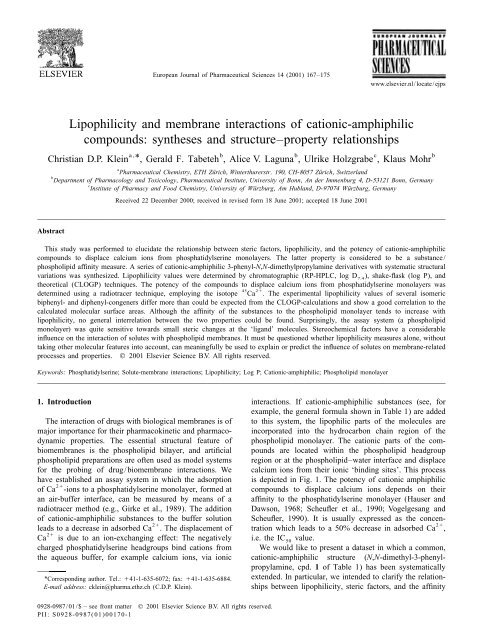

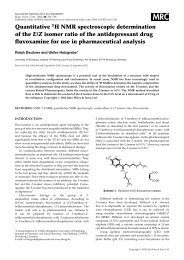
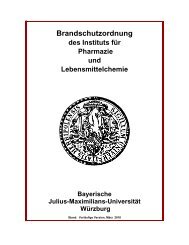
![[2 + 2 + 2]-Cycloaddition of Nitriles with Acetylene - Institut für ...](https://img.yumpu.com/25283701/1/190x245/2-2-2-cycloaddition-of-nitriles-with-acetylene-institut-fur-.jpg?quality=85)
